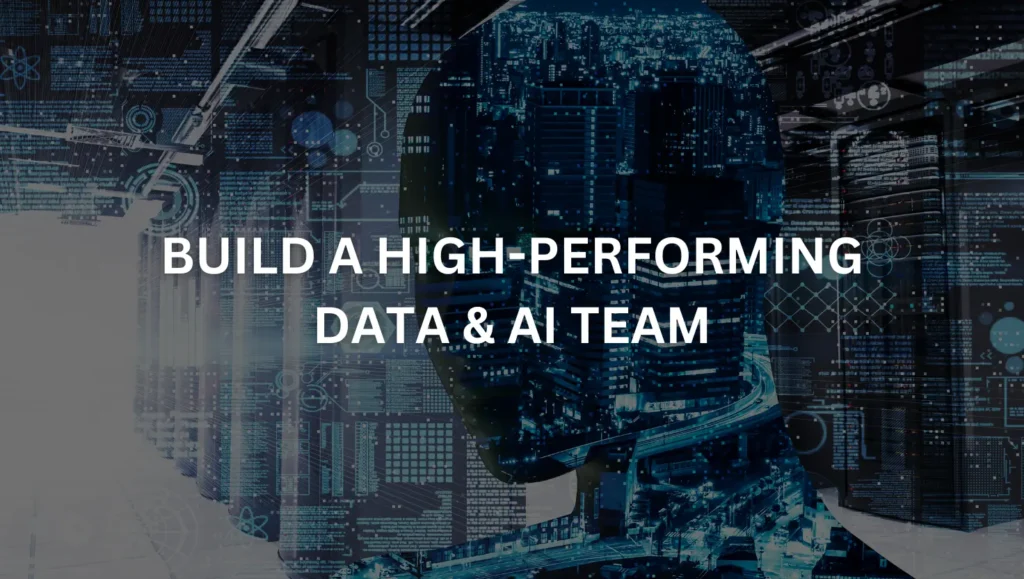In today’s rapidly evolving digital landscape, businesses increasingly depend on data and artificial intelligence (AI) to fuel innovation, streamline operations, and enhance decision-making. Establishing a high-performing Data and AI team has shifted from being a competitive advantage to a necessity. For organizations aiming to lead in their industry, building such a team is pivotal. This comprehensive guide explores the critical steps and considerations to create a team that excels in leveraging data and AI to achieve impactful results.
Why Do You Need a High-Performing Data and AI Team?
Drive Data-Driven Decisions:
Data is the backbone of informed decision-making. High-performing teams analyze patterns, predict trends, and deliver actionable insights, allowing organizations to make evidence-based choices that drive growth and efficiency.
Foster Innovation:
AI empowers businesses to explore new possibilities, such as predictive modeling, automated processes, and hyper-personalized customer experiences. These innovations help companies stay ahead of the curve.
Stay Competitive:
Industries such as healthcare, finance, and retail increasingly leverage advanced data capabilities. Businesses that invest in data and AI teams outperform their competitors by unlocking deeper insights and delivering superior results.
Boost Operational Efficiency:
By integrating AI-powered tools and automation, teams can streamline workflows, optimize resources, and reduce costs. Efficiency allows organizations to focus on strategic priorities.
Key Roles for Your Data and AI Team
To establish a robust and effective Data and AI team, it is crucial to assemble professionals with diverse expertise. Here are the key roles.
Data Scientists:
These professionals specialize in statistical modeling, programming, and machine learning. They design algorithms and models to solve complex problems and extract valuable insights from data.
Data Engineers:
Data engineers ensure that the data pipeline is reliable, scalable, and efficient. They create and maintain systems that enable seamless data storage, access, and processing.

AI/ML Engineers:
These engineers specialize in deploying machine learning models in real-world applications. They bridge the gap between research and production, ensuring models are scalable and performant.
Data Analysts:
Data analysts focus on interpreting raw data and converting it into actionable insights. They guide business strategies by identifying trends and patterns.
Business Analysts:
Acting as a bridge between technical teams and business stakeholders, business analysts ensure that technical solutions align with organizational goals and deliver measurable value.
Domain Experts:
Industry-specific knowledge is critical for contextualizing data and ensuring relevance. Domain experts enable teams to tailor solutions to specific challenges.
AI Strategists:
AI strategists align data and AI initiatives with the company’s overarching vision. They prioritize projects based on business goals and ensure maximum impact.
Steps to Build Your Data and AI Team
Define Your Objectives:
To build a focused team, start by outlining your objectives. What do you aim to achieve through data and AI? Examples could include enhancing customer experiences with predictive analytics, optimizing supply chain processes, or automating repetitive tasks. A clearly defined roadmap with short- and long-term goals ensures alignment and prioritization of resources.
Assess Current Capabilities:
Evaluate your existing team’s skills, infrastructure, and tools. Identifying gaps in expertise or technology provides clarity on what’s needed to achieve your objectives. Consider conducting skill audits and leveraging competency matrices to pinpoint areas for improvement.
Hire Strategically:
Recruiting the right talent is a cornerstone of success. Seek candidates who combine technical expertise with problem-solving capabilities. Platforms like LinkedIn, Kaggle, and GitHub can help identify exceptional talent. You can also contact Accel DNA to hire the most skilled AI & Data talent in New York. Partnering with universities and offering internship programs can also build a pipeline of skilled professionals.
Invest in Tools and Technologies:
Modern tools empower teams to work efficiently and deliver high-impact results. Examples include:
- Data Visualization Tools: Tableau, Power BI, Looker
- AI Frameworks: TensorFlow, PyTorch, Scikit-Learn.
- Cloud Platforms: AWS, Google Cloud, Microsoft Azure
Emerging technologies like MLOps platforms and synthetic data generation tools further enhance scalability and efficiency.

Foster a Collaborative Culture:
Collaboration is essential for innovation. Encourage cross-functional teamwork between technical experts and business units. Create a safe environment where experimentation is embraced, and failures are viewed as learning opportunities. Agile methodologies help teams adapt to changing priorities seamlessly.
Provide Ongoing Training and Development:
The field of data and AI is rapidly evolving. Equip your team with the latest knowledge and skills by offering access to:
- Online courses (Coursera, Udemy, edX)
- Internal training programs and certifications
- Industry conferences and seminars
Encourage continuous learning to ensure your team remains at the forefront of technological advancements.
Monitor Performance and Iterate:
Set clear KPIs to evaluate success, such as:
- Accuracy of predictive models
- Speed and efficiency of data processing
- Measurable business outcomes derived from insights
Regularly review progress and refine strategies to address shortcomings. Feedback loops enable teams to continuously improve and align with organizational goals.
Real-World Use Cases and Case Studies
Real-World Case Studies:
The Retail Industry
A global retail chain implemented an AI-driven recommendation engine developed by its Data and AI team. By analyzing customer purchasing patterns, the team created personalized shopping experiences, increasing sales by 25% in six months.
The Healthcare Sector
A healthcare provider leveraged predictive analytics to anticipate patient admissions during the flu season. The insights helped allocate resources effectively, reducing wait times by 30% and improving patient satisfaction.
Real-World Use Cases:
Predictive Maintenance
Manufacturing firms use AI to monitor equipment health. By predicting failures before they occur, businesses minimize downtime and save millions in repair costs.
Fraud Detection
Financial institutions rely on AI algorithms to detect unusual transaction patterns, preventing fraud and safeguarding customer assets.

Are you ready to build a high-performing Data and AI team? Contact us for expert guidance tailored to your unique business needs.
Conclusion
Building a high-performing Data and AI team requires a strategic approach, innovation commitment, and collaboration culture. By assembling the right mix of talent, investing in cutting-edge tools, and fostering continuous learning, your organization can unlock the transformative potential of data and AI to achieve remarkable outcomes.
Frequently Asked Questions
1. What are the key roles in a Data and AI team?
A high-performing team includes data scientists, data engineers, AI/ML engineers, data analysts, business analysts, domain experts, and AI strategists.
2. How can businesses ensure their Data and AI team stays competitive?
Provide ongoing training, invest in cutting-edge tools, and foster a culture of collaboration and innovation.
3. What challenges do companies face when building a Data and AI team?
Common challenges include talent shortages, scalability issues, and ethical concerns. These can be addressed through strategic hiring, cloud-based solutions, and strong governance frameworks.
4. How do AI-driven teams add value to businesses?
They enable data-driven decisions, foster innovation, enhance efficiency, and maintain a competitive edge in the market.
5. What tools are essential for a Data and AI team?
Popular tools include Tableau, TensorFlow, Power BI, AWS, and Microsoft Azure for data visualization, AI model deployment, and cloud computing.


